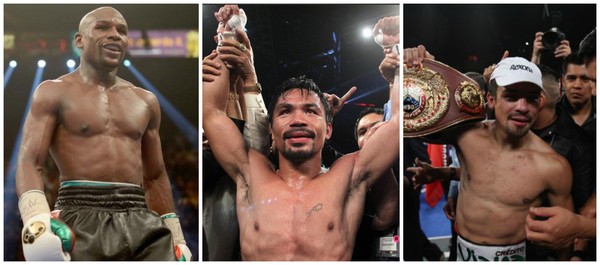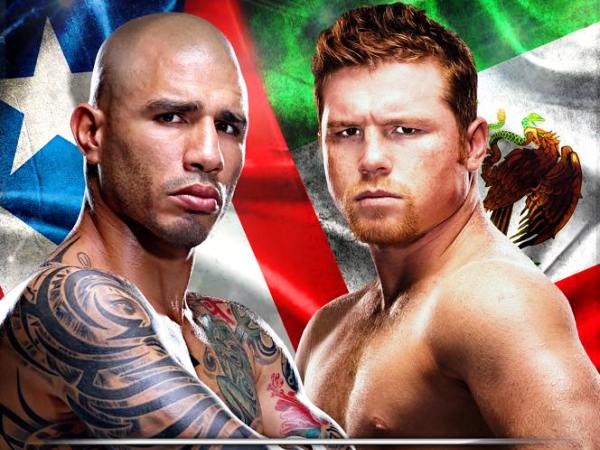Who Did It Better? Part 2
With just days to go before May 2, Mayweather vs Pacquiao is upon us, and as part of our coverage of this megafight, Eliott and Rafa offer a rigorous analysis of Floyd’s and Manny’s fights against their five common opponents. To do so, they will follow the chronological order in which Mayweather faced them because, let’s face it, that’s the way the A-side of #MayPac would want it done. In Part 1 they assessed Floyd’s and Manny’s performances against Oscar De La Hoya and Ricky Hatton. Today they look at that fabulous conterpunching former lightweight, Juan Manuel Marquez.
Juan Manuel Marquez
2009-09-19: Floyd Mayweather UD Juan Manuel Marquez
2004-05-08: Juan Manuel Marquez D Manny Pacquiao
2008-03-15: Manny Pacquiao SD Juan Manuel Marquez
2011-11-12: Manny Pacquiao MD Juan Manuel Marquez
2012-12-08: Juan Manuel Marquez KO6 Manny Pacquiao

Rafael Garcia: In September of 2009, Floyd Mayweather and Juan Manuel Marquez met in a bout that signaled Mayweather’s return to the ring after a 21-month retirement following his knockout of Ricky Hatton. The boxing world loudly clamored for Mayweather’s return given that Pacquiao had looked phenomenal against both De La Hoya and Hatton, making us salivate at the thought of a potential clash for pound-for-pound supremacy. For his part, Marquez was coming off a great performance against Juan Diaz in which he earned the lineal lightweight title, and it was in the post-fight interview to that bout when he surprised the boxing world by calling out a then still-retired Floyd Mayweather Jr.
But by the time Floyd and Juan Manuel met in the ring in 2009, Marquez and Pacquiao were already involved in an unfinished rivalry. Their first fight took place at the featherweight limit in 2004 and ended in a draw; the second occurred at super-featherweight and produced a razor-thin split decision in Pacquiao’s favour. Both Pacquiao vs Marquez fights were technically mesmerizing, violent and thrilling, a perfect amalgam of the Filipino’s violent instincts, the Mexican’s professorial counterpunching, and both prizefighters’ tremendous courage. Importantly, both fights happened at weights that suited both combatants at the time, and you could make a case both of them were at or near their primes. The playing field for both Pacquiao vs Marquez bouts was as level as anyone could wish for, and that mirrored itself in the fact it became impossible to objectively pick who was the better fighter.
This was not the case with Mayweather vs Marquez. The Mexican climbed up in weight two divisions for the fight, only for Money May to disregard the bout’s catchweight at the scales. In the ring Marquez found himself the smaller and shorter man, fighting for the first time at welterweight against a still formidable Floyd. The result was an embarrassingly one-sided contest in which Floyd’s advantages in speed and accuracy were so absolute they rendered mute any complaints about frame-size and mass differentials. Moreover, the message Mayweather sent to Pacquiao and to the rest of the boxing world with his victory over Marquez was impossible to miss: Money May was back—“better than ever” in the words of Jim Lampley—and he had completely outclassed the rival who had given Pacquiao two of his toughest fights.

It took Mayweather only 12 rounds to prove his superiority over Marquez, but the third Pacquiao vs Marquez fight yielded only a majority decision for the Pacman. Even worse, most observers believed Marquez had done more than enough to earn the judges’ nod in the rubbermatch; either way, closure would have to wait until that infamous night in December of 2012. In their fourth confrontation, Marquez pulled a couple of rabbits out of the hat by sending Pacquiao to the canvas twice, the second time with a perfectly timed right hand that rendered the Filipino unconscious. Closure achieved at last, but not in Manny’s favour.
Eliott McCormick: The sample size for this comparison is clearly skewed, but I don’t think it can be seen as anything other than a clear win for Floyd, given his utter domination of Marquez. There wasn’t one minute of that fight in which Mayweather was threatened. Marquez was much slower, a second behind at every stage. There was also this highlight, a moment of astounding physical beauty (fast forward to 4:45); Floyd completely outwits a Hall of Fame fighter, turning him into a hapless, bumbling dupe.
Individual moments of brilliance don’t solely get you the nod, of course. Manny Pacquiao had several of those in his four meetings with Marquez. In the first round of fight 1, it looked like a complete mismatch until JMM boxed his way back and made a significant pitch for the win. Though Pacquiao won the following two matches they could have easily gone in Marquez’s favour. Then, in their fourth fight, which remains one of the most thrilling boxing matches I’ve ever watched, Marquez returned from the brink of defeat to land one of the decade’s most shocking punches and earn the only definitive win of their series.

Pacquiao’s frenetic punching sometimes makes him defensively vulnerable, and as an intelligent counterpuncher Marquez repeatedly exploited this flaw. Floyd Mayweather is the antithesis of risk-taking, and JMM had no such opportunities to stand in front of Floyd and land combinations. While the sample size for Pacquiao versus Marquez is so much greater, we know that each man was equally matched across several weights and that if they continued to face one another we’d likely get more competitive fights that could go either way. Conversely, because of how stylistically unsuited Mayweather is for Marquez, I envision any further meetings between them being a carbon copy of the first one.
Prior to that match, Floyd conducted a now-infamous interview with ESPN’s Brian Kenny, who asked him why he’d chosen to return against the lightweight champ rather than Manny Pacquiao. This prompted a shouting match in which Floyd rudely dismissed Kenny’s boxing acumen and denigrated Pacquiao’s ability. Floyd said that he’d chosen Marquez because he’d called him out, which rang hollow given the various other fighters who’d made the same overtures. Kenny insinuated—accurately—that Floyd was acting opportunistically by coming back against someone possessive of great talent but who would be hampered by a size handicap. Despite this, there’s no denying the fact that Floyd impressed by thoroughly outboxing a great boxer after a two year layoff.
Floyd chose to come back against someone he’d look good against and who also gave his Pacquiao his most difficult outings. Thus, whipping “Dinamita” gave him further leverage in the pound-for-pound debate. Floyd received everything he wished for against Marquez. And, while JMM showed Manny’s vulnerabilities, the only thing we learned in his fight was just how good Mayweather is.
Score: Mayweather 2 / Pacquiao 1





